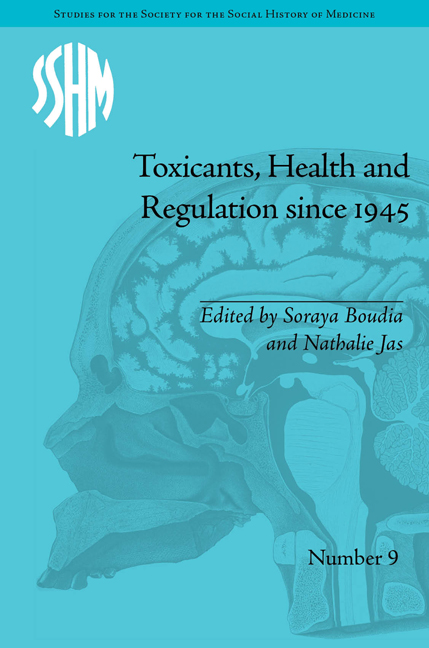Book contents
- Frontmatter
- Contents
- Acknowledgements
- List of Figures and Tables
- List of Contributors
- Introduction
- 1 The Cold War Over the Worker's Body: Cross-National Clashes Over Maximum Allowable Concentrations in the Post-World War II Era
- 2 Adapting To ‘Reality’: The Emergence of an International Expertise On Food Additives and Contaminants in the 1950s and Early 1960s
- 3 From Threshold to Risk: Exposure to Low Doses of Radiation and its Effects On Toxicants Regulation
- 4 ‘License To Expose’? Occupational Exposure Limits, Scientific Expertise and State in Contemporary France
- 5 Chemical Infrastructures of the St Clair River
- 6 Managing an Everlastingly Polluted World: Food Policies And Community Health Actions in the French West Indies
- 7 Chernobyl Empowerment? Exporting ‘Participatory Governance’ to Contaminated Territories
- Notes
- Index
Introduction
- Frontmatter
- Contents
- Acknowledgements
- List of Figures and Tables
- List of Contributors
- Introduction
- 1 The Cold War Over the Worker's Body: Cross-National Clashes Over Maximum Allowable Concentrations in the Post-World War II Era
- 2 Adapting To ‘Reality’: The Emergence of an International Expertise On Food Additives and Contaminants in the 1950s and Early 1960s
- 3 From Threshold to Risk: Exposure to Low Doses of Radiation and its Effects On Toxicants Regulation
- 4 ‘License To Expose’? Occupational Exposure Limits, Scientific Expertise and State in Contemporary France
- 5 Chemical Infrastructures of the St Clair River
- 6 Managing an Everlastingly Polluted World: Food Policies And Community Health Actions in the French West Indies
- 7 Chernobyl Empowerment? Exporting ‘Participatory Governance’ to Contaminated Territories
- Notes
- Index
Summary
In April 2004, as discussions reached a conclusion on the new European Community regulation on chemicals and their safe use (EC 1907/2006), dealing with the Registration, Evaluation, Authorization and Restriction of Chemical substances (REACH), the WWF publicized the results of blood tests on thirty-nine European Members of Parliament (MPs) who were not exposed to any particular chemical pollutants. No fewer than 76 persistent toxic chemical substances were found in their blood, out of the 101 for which they had been tested. On average, each MP carried a cocktail of forty-one toxic products composed of substances that were persistent (not biodegradable) and bio-accumulative (that accumulate in the body). Thirteen chemical residues (phtalates, perfluorinated components) were systematically found in all the MPs' blood samples.
Since the early 1990s, revealing the systematic presence of toxic chemical substances in each individual's body and measuring the ‘toxic body burden’ has become one of the main means of action for activist organizations like the WWF. But the toxic body burden is more than that; it has also become a research subject for public health specialists, doctors, toxicologists and biologists increasingly interested in the effects of substances present almost permanently in human bodies. Surveys highlighting the increasing contamination of human bodies are also undertaken by government institutions such as the US Center for Disease Control (CDC), which has set up programmes that regularly measure and publish results confirming the presence of numerous chemical contaminants in human bodies.
- Type
- Chapter
- Information
- Toxicants, Health and Regulation since 1945 , pp. 1 - 24Publisher: Pickering & ChattoFirst published in: 2014



